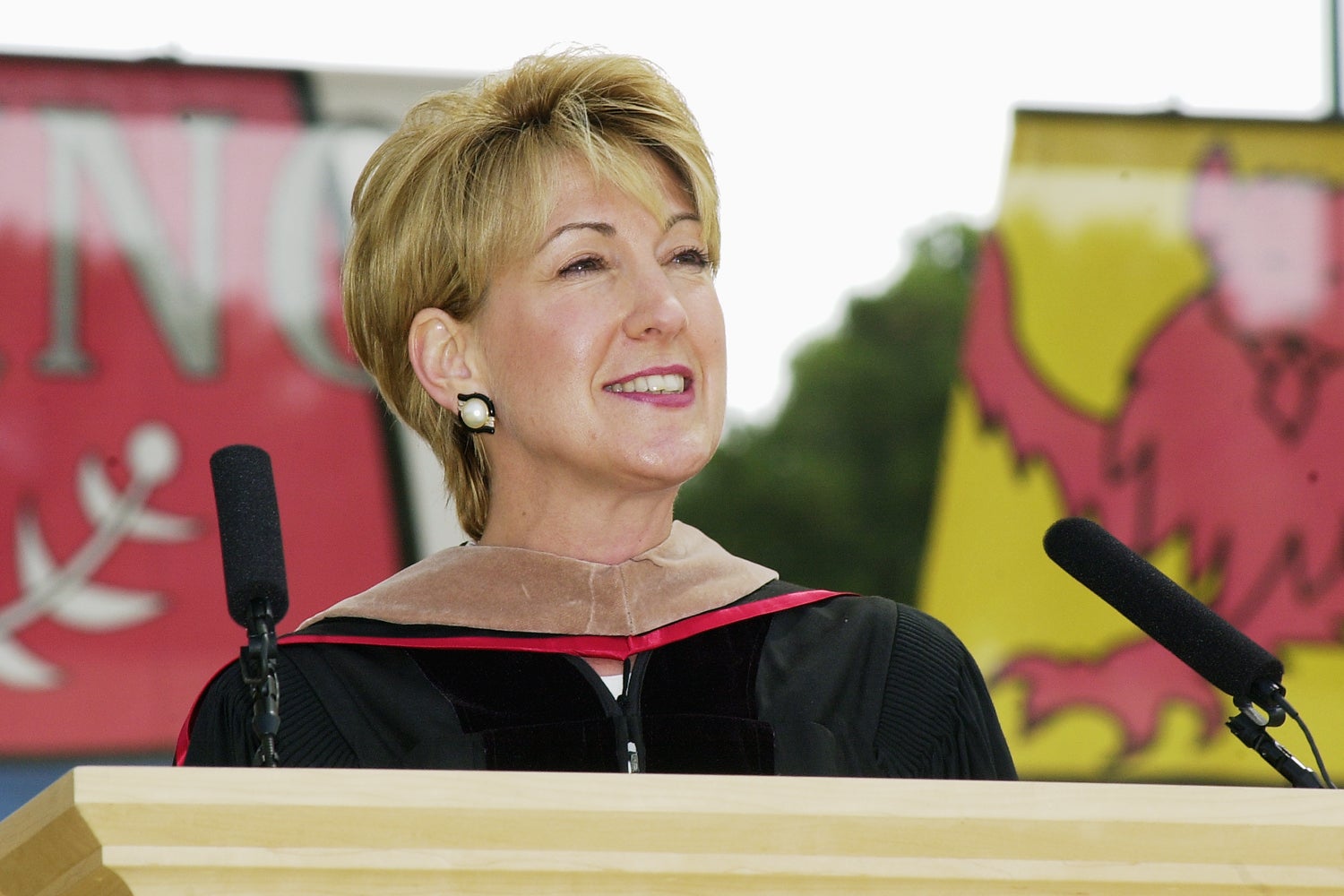Turn fear into motivation, Fiorina says
About 29,000 attend main ceremonies.
“Wacky, wonderful, witty, winsome, willing, waiting.” That is how Rabbi Patricia Karlin-Neumann, associate dean for religious life, described the Stanford Class of 2001 Sunday at the university’s 110th Commencement, which featured an address by Carleton (Carly) S. Fiorina, chief executive officer of Hewlett-Packard Co.

Carleton “Carly” S. Fiorina, chief executive officer of Hewlett-Packard, delivers the Commencement address. (Image credit: L.A. Cicero)
Several thousand graduates, sitting on the grass at the center of the Stanford Stadium, had just made good on the first part of this description by running around the stadium and goofing off as part of the traditional and spirited Wacky Walk — Stanford’s nonconformist answer to the more mainstream (and, some would say, boring) commencement processional.
While there were plenty of caps and gowns, these generally were festooned with accoutrements like fairy wings, boas and balloons. One group of students had attached white dots to their black gowns, giving them the appearance of dominoes. At one point, they lined up and fell down — like dominoes. Some other students held aloft an inflatable pool. Still others played Wiffle ball.
As President John Hennessy welcomed the approximately 29,000 students, family members, former and current university trustees and others, he gave a special mention to former U.S. President Bill Clinton and Sen. Hillary Rodham Clinton, D-N.Y., who attended the event to watch their daughter, Chelsea, graduate with a bachelor’s degree in history.
Hennessy, who was taking part in his first commencement as president, also announced the numbers and types of degrees: 1,768 bachelor’s degrees, 2,132 master’s degrees and 899 doctoral degrees, as well as 363 departmental honors. (John Etchemendy, who fell ill, was unable to attend what would have been his first commencement as provost.)
“You may have noticed that I started out with a lot of numbers, but before you jump to the conclusion that I do this because I’m an engineer and computer scientist, let me say that this recitation of statistics is a Stanford tradition,” Hennessy said.
He pointed out that all traditions start as something new but, after a while, become ingrained and sometimes even antiquated.
“In its own strange way, even the Wacky Walk, which you just observed and which I’m sure many of our guests find anything but traditional, has become a storied part of Stanford,” he said. “However, with the inventiveness of Stanford students, I know the Wacky Walk will never become antiquated.”
But relying on tradition is not enough, Hennessy said. “No matter how visionary the founders were, they could not have begun to imagine the ways that our world would change,” he said.
Hennessy said that, when making decisions, he often tries to put himself in the position of future members of the Stanford community “in the same way that earlier generations of Stanford leaders had to look forward and postulate how their decisions might affect us.”
Maintaining a university of high degree cannot be done by standing still, he said. “It requires us to be bold in launching new efforts and in seeking out new ways to build on the foundation of our predecessors.”
For the graduates, however, looking to the future can be frightening, said Fiorina, who earned her bachelor’s degree from Stanford in 1976.
“And while much was different about my time here, some things are similar: We were in the throes of an energy crisis. In fact, the speaker at my commencement spoke on energy conservation,” Fiorina said. “‘Stagflation’ confounded the market. Employment prospects for graduating seniors were — let’s face it — grim.”
She noted that while recent classes have graduated from Stanford with the prospect of a good job market, things have changed.
“If Spring Quarter had you feeling anything like I did at the prospect of graduating, underneath that cap and gown — and everything else you have on your heads — your fear is great or greater than your excitement today,” she said. “If you’re scared today, let me ask you this: What will you do with your fear? Will you let it become a motivator or an inhibitor?”
She said that one of her most valuable classes at Stanford involved reading great works of medieval philosophy. Each text was enormous, but she and her classmates had to distill each writer’s philosophical discourse to two pages.
“First you’d shoot for 20 pages. Then you’d edit to 10. Then five. Then, finally, two,” she said. “It rendered all the fat out of a body of ideas, boiling it down to the very essence of its meaning.”
Learning to distill this vast quantity of material was a valuable lesson, she said. “The intellectual process I learned in that class is also life’s process,” she said.
“Remember to encourage one another. Remind each other that life is just going to get better and better if you let your fear motivate you to begin a rigorous, but enormously satisfying, lifelong process of distillation: a process of writing your two-page, single-spaced story,” Fiorina said. “As you do your editing and decide what to leave in and what to leave out, you will recognize the choices that are true to your essence.”
